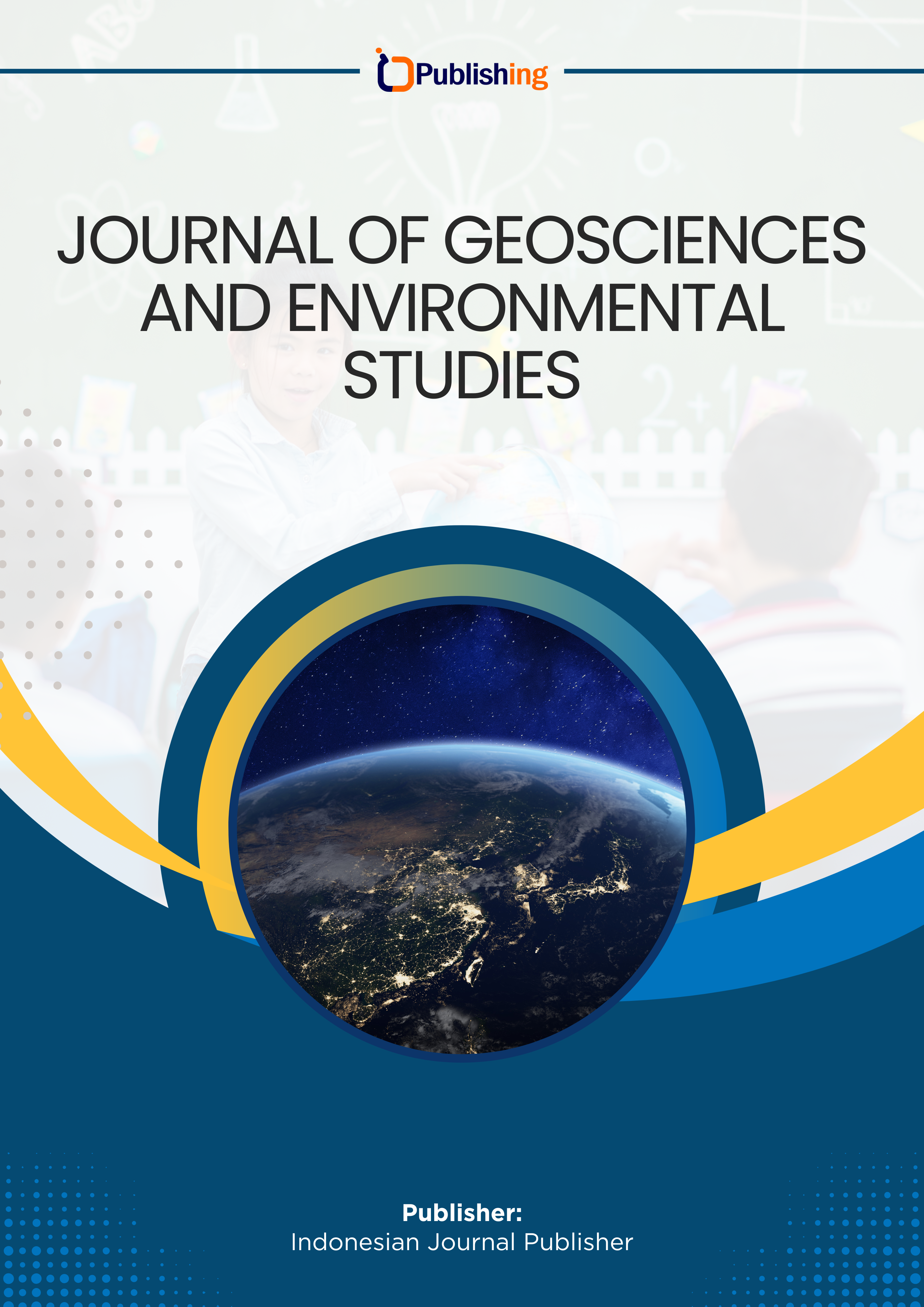Spatial Changes in the Settlement of Panta'nakan Lolo Tourism Village, Kesu District, North Toraja Regency
DOI:
https://doi.org/10.53697/ijgaes.v2i1.3547Keywords:
Spatial Change, Settlements, TourismAbstract
The tourism sector is growing rapidly and emerging as a key driver of regional development. One approach to fostering tourism is establishing Tourism Villages, such as Panta'nakan Lolo Village, which capitalizes on its tourism potential. As a tourist village, it features iconic attractions like Ke'te Kesu. Tourism development has driven increased accommodations alongside physical and spatial changes in the settlement environment. These include new construction, spatial reorganization, and changes in tourism activities and management. This study examines spatial changes in Panta'nakan Lolo Village's settlements before and after its designation as a Tourism Village. Using a qualitative method, data were collected through field surveys, in-depth interviews, and documentation. Spatial-temporal analysis identified changes in land use patterns during 2012, 2018, and 2024. Additionally, settlement patterns were assessed using the Nearest Neighbor Analysis approach with ArcGIS software. The results reveal significant spatial transformations linked to the village’s tourism development. These changes include expanded built-up areas, integration of tourism elements into settlements, and the rise of tourism-related activities and management systems.
References
Adrianus S. Girikallo. (2023). The Influence of Sustainable Tourists Destination Attractiveness and Tourism Marketing Strategy on Tourism Sustainability in South Sulawesi Indonesia. Jurnal Riset Ekonomi dan Akuntansi, 1(4), 375–394. https://doi.org/10.54066/jrea-itb.v1i4.1696 DOI: https://doi.org/10.54066/jrea-itb.v1i4.1696
Barumbun, L. A., & Ridha, M. R. (2017). Objek Wisata Ke ’ te Kesu ’ (1975 -2017). Jurnal Pattingalloang, 5(2), 17–26. https://doi.org/10.26858/pattingalloang.v5i2.8466
Bura, P. P., & Ando, T. (2024). Study Tana Toraja's and Mamasa Toraja's settlement composition in Sulawesi, Indonesia. Journal of Asian Architecture and Building Engineering, 23(5), 1826–1839. https://doi.org/10.1080/13467581.2023.2278457 DOI: https://doi.org/10.1080/13467581.2023.2278457
Eka, & Hudiono, R. K. (2020). KETERLIBATAN MASYARAKAT DI OBJEK WISATA PALAWA’: Studi Kasus Desa Wisata Palawa’ Kabupaten Toraja Utara. Kritis, 29(2), 120–134. https://doi.org/10.24246/kritis.v29i2p120-134 DOI: https://doi.org/10.24246/kritis.v29i2p120-134
Hantari, A. N., & Nareswari, A. (2021). Pengaruh Wisata Terhadap Perubahan Spasial Permukiman Di Desa Wisata Adiluhur, Kebumen. 2877, 81–90. https://doi.org/10.14710/mdl.21.2.2021.81-90 DOI: https://doi.org/10.14710/mdl.21.2.2021.81-90
Kartika, I. M., Sujana, I. G., & Jehapu, A. (2020). Pengaruh Perkembangan Pariwisata Terhadap Perubahan Alih Fungsi Lahan Di Desa Canggu Kecamatan Kuta Utara Kabupaten Badung. Widya Accarya, 11(1), 51–62. https://doi.org/10.46650/wa.11.1.834.51-62 DOI: https://doi.org/10.46650/wa.11.1.834.51-62
Kausar, D. R. K., & Gunawan, M. P. (2018). Managing heritage tourism in Toraja: Strengthening local values and improving tourists’ experiences. Journal of Heritage Tourism, 13(6), 550–561. https://doi.org/10.1080/1743873X.2017.1411356 DOI: https://doi.org/10.1080/1743873X.2017.1411356
Khan, N. A., Enam, A., Habib, M. A., & Konduri, K. C. (2023). Exploring joint activity-tour participation, time allocation, and mode choice decisions. Transportation Letters, 15(9), 1191–1201. https://doi.org/10.1080/19427867.2022.2144381 DOI: https://doi.org/10.1080/19427867.2022.2144381
Kompasiana. (2024). Analisis Perubahan Penggunaan Lahan Akibat Pembangunan Kawasan Wisata Mandalika di Lombok. www.kompasiana.com. https://www.kompasiana.com/abaybeezalt7092/6661dafeed64154a3076f702/analisis-perubahan-penggunaan-lahan-akibat-pembangunan-kawasan-wisata-mandalika-di-lombok?utm_source=chatgpt.com
Kong, L., He, Z., Chen, Z., Luo, M., Du, Z., Zhu, F., & He, L. (2021). Spatial distribution and morphological identification of regional urban settlements based on road intersections. ISPRS International Journal of Geo-Information, 10(4). https://doi.org/10.3390/ijgi10040201 DOI: https://doi.org/10.3390/ijgi10040201
Lenaini, I., Islam, U., Raden, N., & Palembang, F. (2021). Teknik Pengambilan Sampel Purposive Dan Snowball Sampling. 6(1), 33–39.
Madandola, M., & Boussaa, D. (2023). Cultural heritage tourism as a catalyst for sustainable development; the case of old Oyo town in Nigeria. International Journal of Heritage Studies, 29(1–2), 21–38. https://doi.org/10.1080/13527258.2023.2169332 DOI: https://doi.org/10.1080/13527258.2023.2169332
Matandung, L. D., Sumiani, & Yatim, H. (2018). Makna Simbolik Tari Pa’Katia Pada Upacara Rambu Solo’ Di Kabupaten Toraja Utara. Jurnal Universitas Negeri Makassar, 3, 349.
Muryanti, M. (2023). Challenges and Opportunities in Developing Rural Tourism Villages: A Case Study of Ngargoretno Village, Indonesia. Society, 11(2), 589–602. https://doi.org/10.33019/society.v11i2.594 DOI: https://doi.org/10.33019/society.v11i2.594
Nguyen, Q. H. (2021). Impact of investment in tourism infrastructure development on attracting international visitors: A nonlinear panel ARDL approach using Vietnam’s data. Economies, 9(3). https://doi.org/10.3390/economies9030131 DOI: https://doi.org/10.3390/economies9030131
Prasetya, F. A. (2024). Analisis Spasial-Temporal Perubahan Penggunaan Lahan Akibat Pembangunan Bandara Internasional Dhoho Kediri Berbasis Data Google Earth. Geodika: Jurnal Kajian Ilmu dan Pendidikan Geografi, 8(1), 65–74. https://doi.org/10.29408/geodika.v8i1.25731 DOI: https://doi.org/10.29408/geodika.v8i1.25731
Pratiwi, W. D., Samsirina, S., Rani, M. S., & Nagari, B. K. (2022). Transformasi Permukiman dan Rumah di Kawasan Hutan Wisata Bandung Selatan. Jurnal Permukiman, 17(2), 93–108. https://doi.org/10.31815/jp.2022.17.93-108 DOI: https://doi.org/10.31815/jp.2022.17.93-108
Sari, D. D. S., Jumadi, & Anton. (2024). Analysis of Settlement Distribution Pattern Based on Topography in Balik Bukit Subdistrict, West Lampung Regency. E3S Web of Conferences, 500. https://doi.org/10.1051/e3sconf/202450002020 DOI: https://doi.org/10.1051/e3sconf/202450002020
Utomo, D. K. S., Gusadi, M. H., Rahmi, U. A., Ramadhan, G., & Pratiwi, W. D. (2024). Identifying 4a’S Component (Attraction, Accessibility Amenity, and Ancillary) in Sade Tourism Village. Jurnal Ilmu Sosial, 22(1), 102–112. https://doi.org/10.54783/dialektika.v22i1.220
Wulandari, N. D., & Setyowati, D. L. (2020). Analisis Pola Persebaran Permukiman Tahun 1998, 2006, dan 2019 di Kecamatan Gunung Pati Kota Semarang. Geo Image, 9(1), 65–72. https://doi.org/10.15294/geoimage.v9i1.38644
Downloads
Published
How to Cite
Issue
Section
License
Copyright (c) 2025 Nila Puspita Sari, Sri Rum Giyarsih, Andri Kurniawan

This work is licensed under a Creative Commons Attribution-ShareAlike 4.0 International License.














